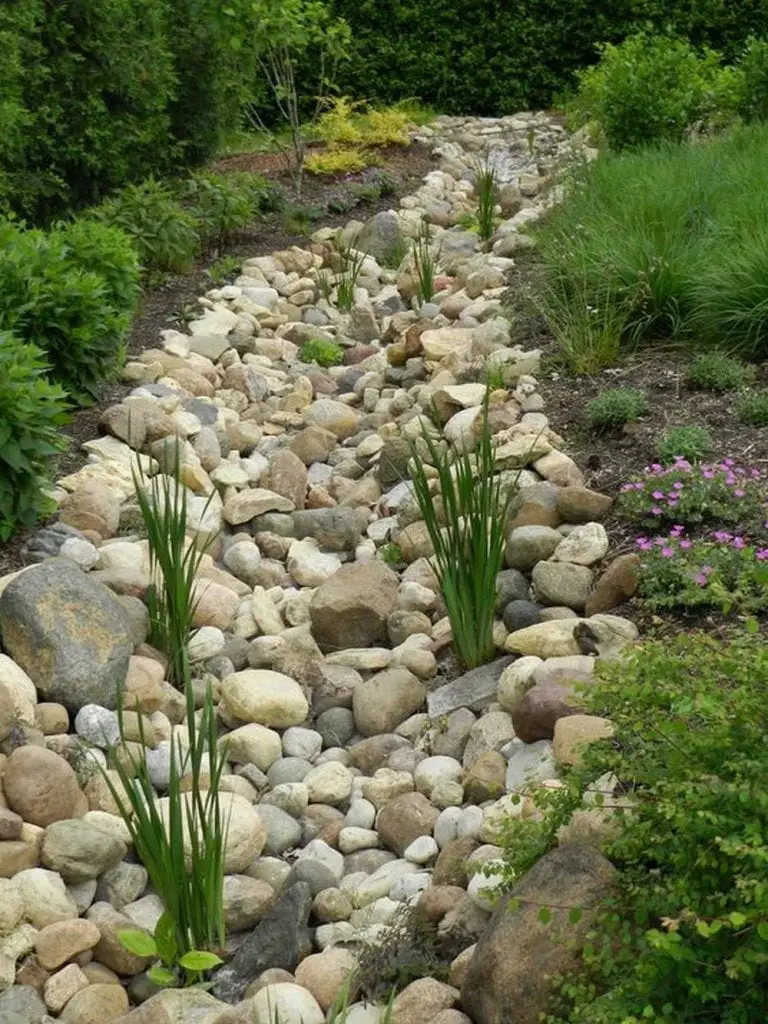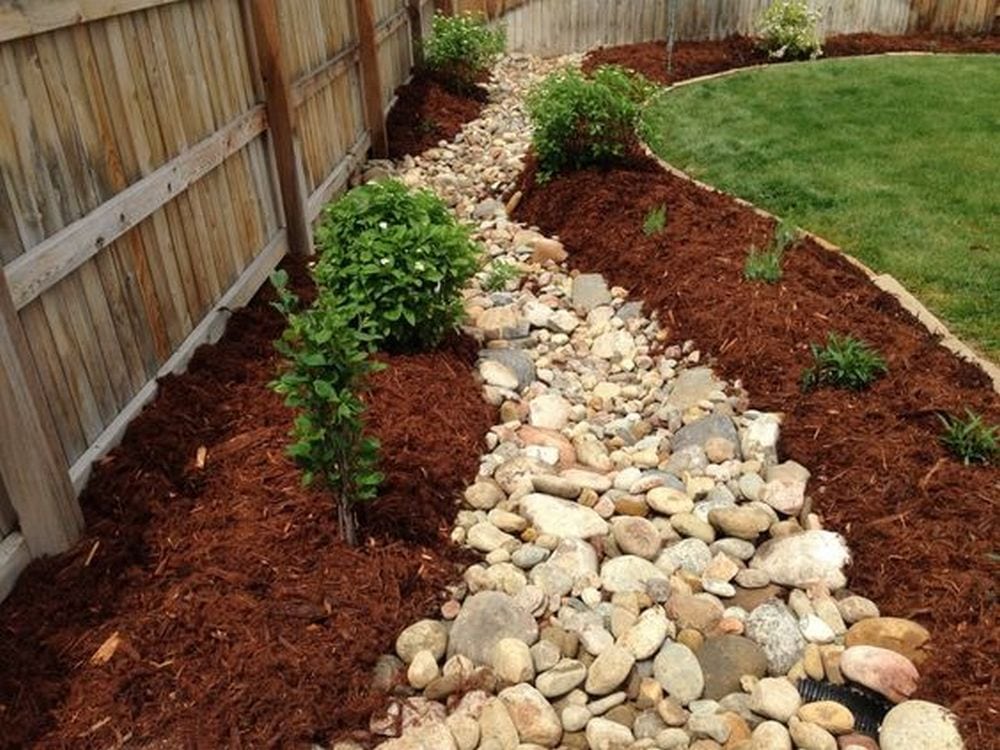
Beautiful landscapes have always impressed me. I can’t help but fall in love with my neighbor’s landscape which she regularly changes every quarter. Admittedly, she says it’s her guilty pleasure and instant stress-reliever.

One thing, though, that remained constant is her dry creek bed. I’ve figured out that, not only is it visually appealing, but it also controls the flow of water. This is really beneficial in areas that are usually hit by heavy rains and floods. Although this isn’t a requirement, it’s better to be safe than sorry.
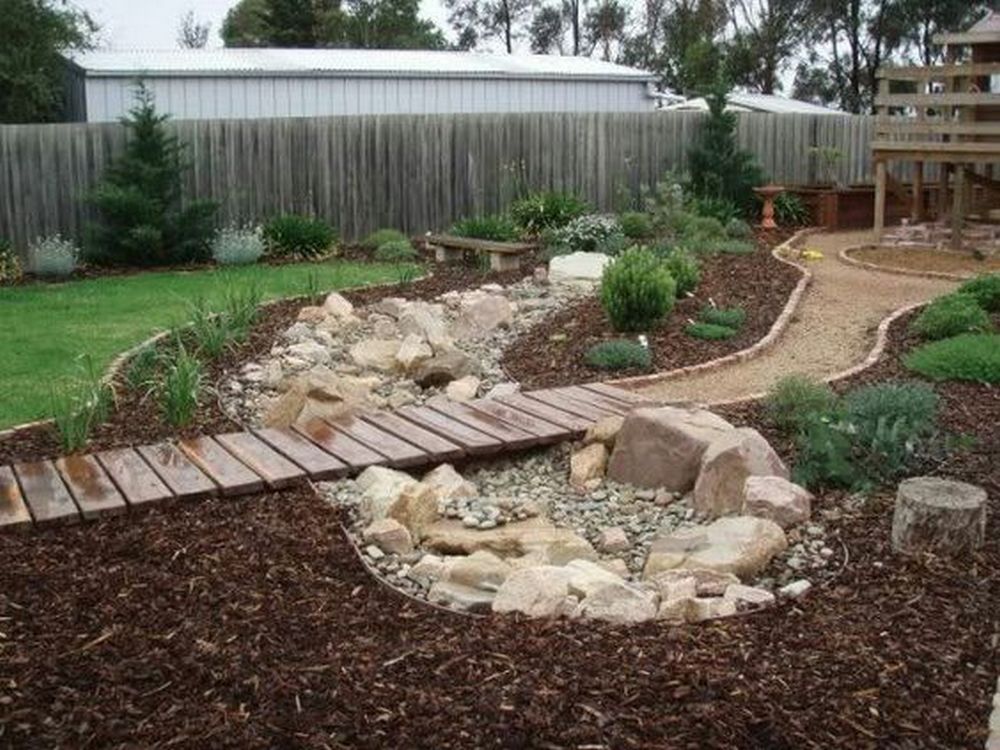
You can make this dry creek bed project with a friend or a loved one. Make sure that you come up with a great plan as to how you’ll do it. This will help you save time and effort.
Contents
Installing a Dry Creek Bed
Materials:
- Weed fabric
- Creek rocks
- River bed cobble
Tools:
- Shovel
- Garden hoe
- Wheelbarrow
- Rake
Steps:
Step 1: Plan and Mark the Layout
Start by determining the path of your dry creek bed. Observe how water naturally flows through your yard after heavy rain. Use marking paint, a garden hose, or stakes with string to outline the creek bed’s shape. A natural, winding path will look more realistic and blend well with your landscape.
Step 2: Dig the Trench
Using a shovel and garden hoe, dig a trench along the marked path. The depth should be around 6 to 12 inches, depending on how much water you need to redirect. For steeper slopes, dig a deeper trench to slow down water flow. The width should vary slightly to create a natural look, with wider areas mimicking small basins.
Step 3: Slope and Shape the Bed
For proper drainage, create a gentle slope within the trench. A slight decline of at least 1 inch per 10 feet will help direct water efficiently. Use a rake to smooth out the base and shape the sides. The creek bed should gradually blend into the surrounding landscape rather than have sharp edges.
Step 4: Line the Trench with Weed Fabric
Lay weed fabric along the entire length of the trench. This prevents weeds from growing while still allowing water to drain through. Secure the fabric with landscape pins or by placing a few rocks on top. Trim excess fabric so it fits neatly within the creek bed.
Step 5: Add Creek Rocks and River Bed Cobble
Start by placing river bed cobble along the base of the trench. These smaller stones help with drainage and create a natural foundation. Then, layer larger creek rocks along the edges and throughout the bed to add structure and visual appeal. Arrange the rocks randomly to mimic a natural dry riverbed.
Step 6: Fine-Tune and Adjust
Step back and assess the overall appearance of the dry creek bed. Adjust rocks as needed to create a balanced, natural-looking design. If desired, add small boulders or driftwood to enhance the effect.
Step 7: Clean Up and Test the Flow
Use a rake to smooth out surrounding soil and ensure the dry creek bed blends into the landscape. If possible, run water through the creek bed using a hose to test the drainage. Make any final adjustments to the slope or rock placement to improve water flow.
Final Touches
For a finished look, consider adding drought-tolerant plants, ornamental grasses, or mulch around the edges. This softens the transition between the creek bed and the rest of your yard, making it look more integrated.
Click on any image to start the lightbox display. Use your Esc key to close the lightbox.
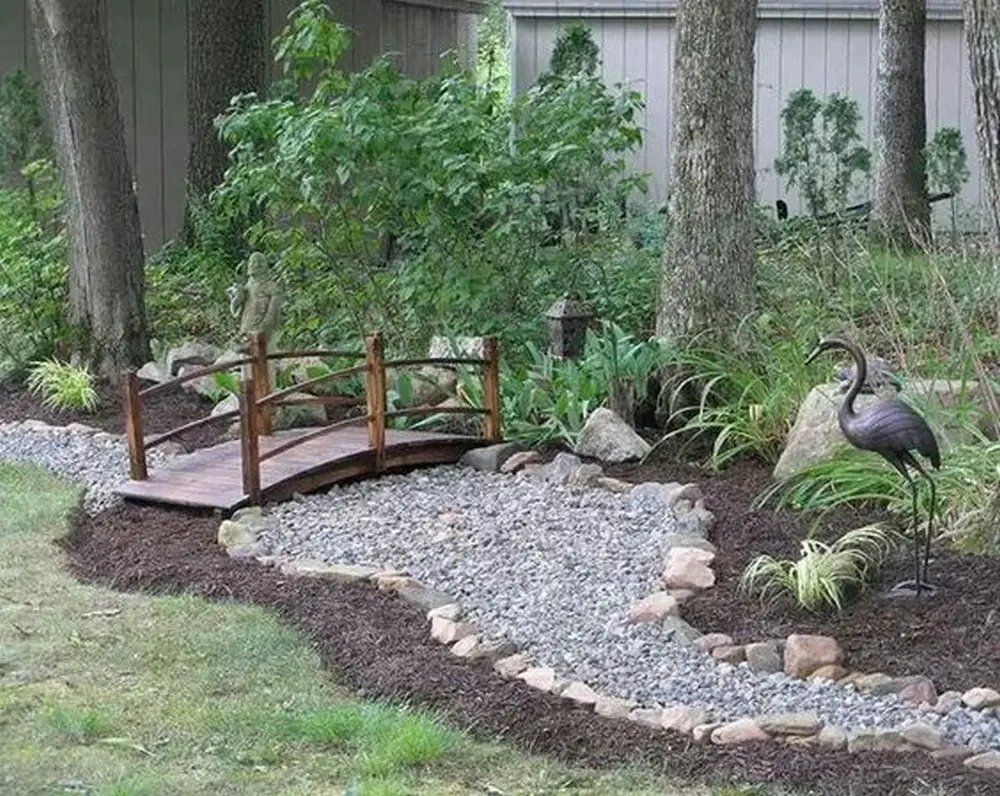

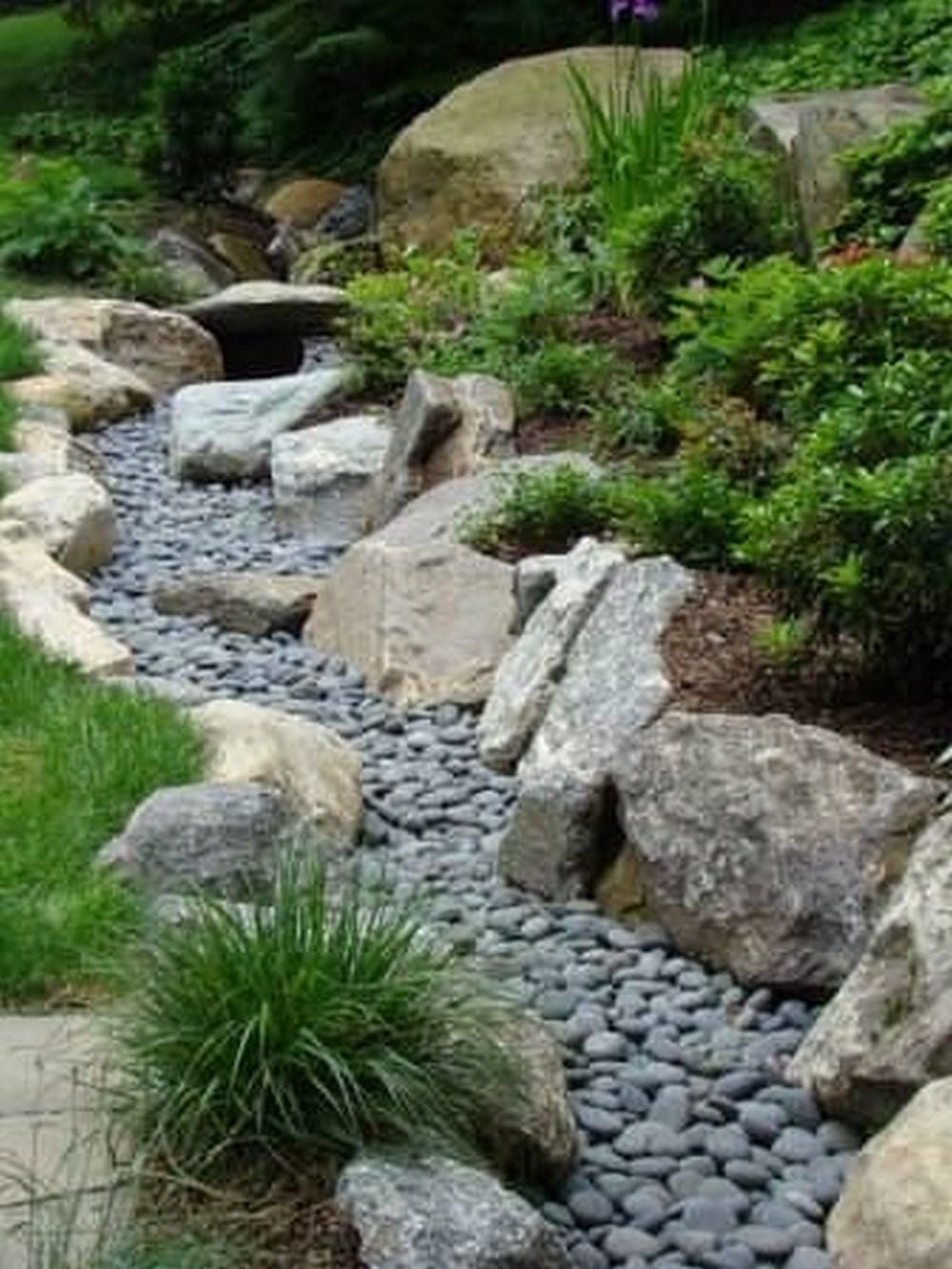
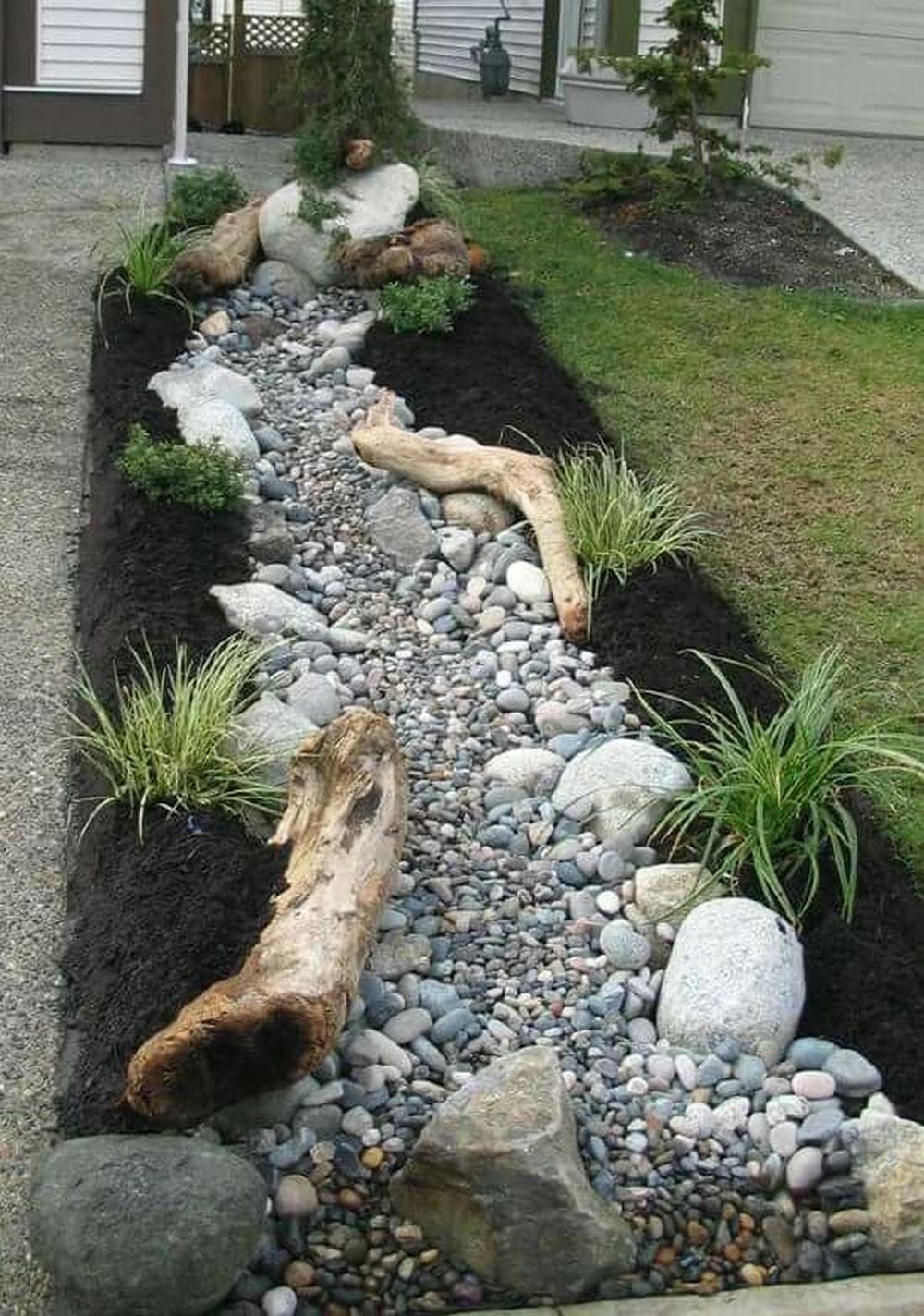
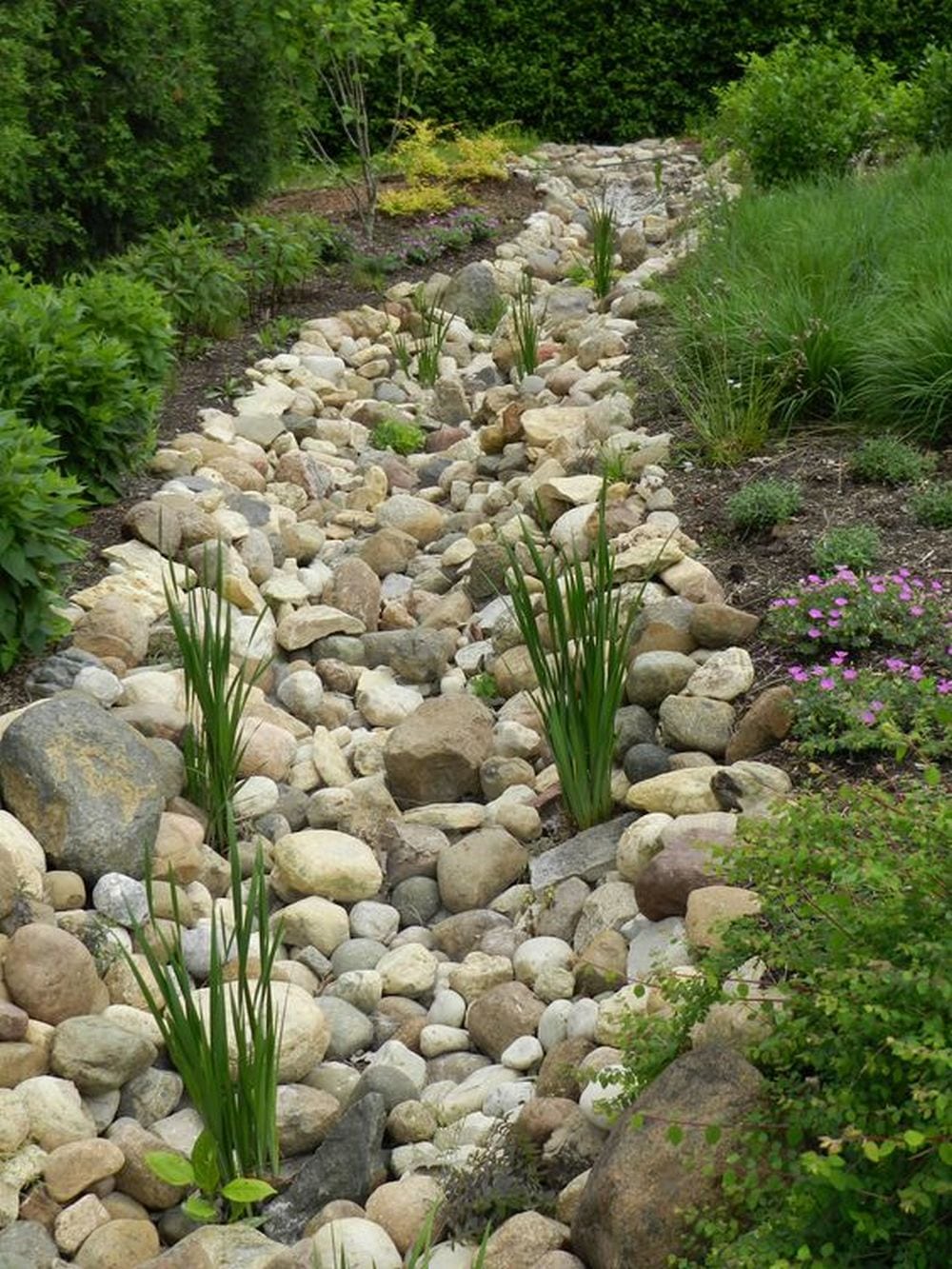

Choosing the Right Location for Your Dry Creek Bed
Selecting the right location is key when planning a dry creek bed for your backyard. A well-placed dry creek bed not only enhances the beauty of your landscape but also effectively manages water flow and prevents issues like soil erosion. Here’s how to choose the best spot for your dry creek bed to ensure both functionality and aesthetic appeal.
Evaluate Your Yard’s Natural Water Flow
Start by observing how water moves through your yard during heavy rain. Look for areas where water tends to pool or flow, such as low-lying sections or slopes. A dry creek bed works best in these spots, as it can act as a natural drainage system, redirecting water away from your home or garden beds.
Consider Slope and Elevation
The ideal location for a dry creek bed is along a natural slope, where gravity can help guide water through the channel. If your yard is mostly flat, you can create a slight slope using a shovel and garden tools. This ensures proper drainage and keeps water from stagnating, which could attract pests.
Keep It Away from Structures
Avoid placing the dry creek bed too close to protect your home’s foundation, patio, or other structures. Instead, position it at least several feet away and use it to channel water toward safer drainage areas. This minimizes the risk of water damage and keeps your landscaping functional.
Enhance the Natural Landscape
A dry creek bed should blend seamlessly into your yard’s design. Choose a location that allows you to incorporate features like plants, boulders, or decorative elements to create a cohesive look. Placing it along a garden edge or weaving it through existing landscaping can enhance its natural appeal.
Choosing the right location for your dry creek bed is a critical step in ensuring its success. By evaluating your yard’s water flow, slope, and proximity to structures, you can create a dry creek bed that is both functional and visually stunning.
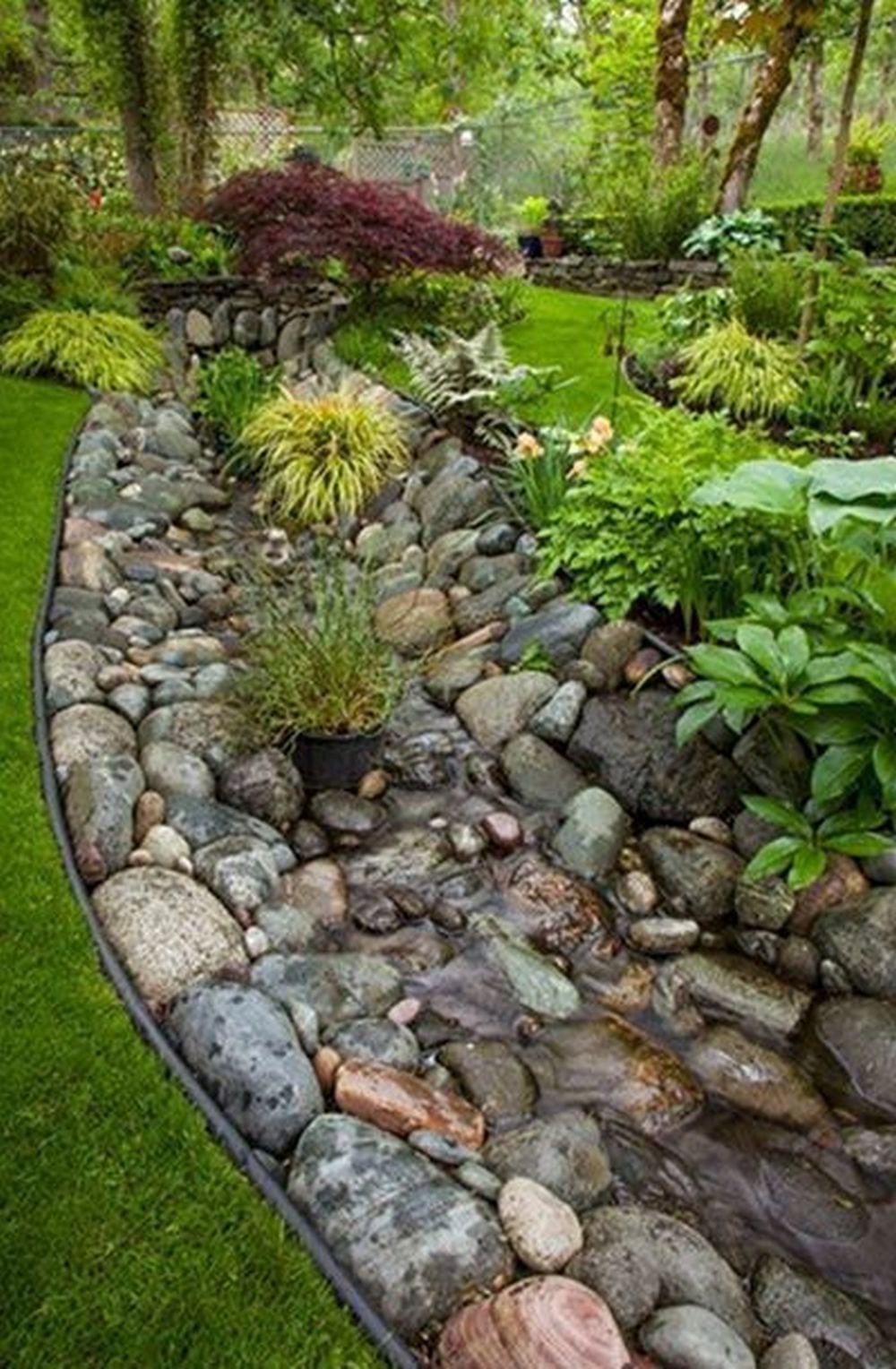
Benefits of a Dry Creek Bed
A dry creek bed is more than just a charming feature for your backyard. It combines functionality and beauty, making it an excellent addition to any landscape. Whether you want to manage water flow, prevent erosion, or enhance your outdoor aesthetics, a dry creek bed offers numerous benefits. Let’s explore the key advantages of incorporating a dry creek bed into your yard.
Controls Water Flow and Prevents Flooding
One of the primary benefits of a dry creek bed is its ability to control water flow. During heavy rains, water tends to pool in low-lying areas, potentially causing flooding and damage to your landscape. A dry creek bed redirects excess water, guiding it safely through your yard and toward a designated drainage area. This helps protect your garden beds, lawn, and home foundation from water damage.
By strategically placing a dry creek bed in areas where water naturally collects, you can prevent issues like standing water or overly saturated soil. This makes it particularly beneficial in regions prone to heavy rainfall or flash floods.
Reduces Soil Erosion
Soil erosion is a common problem in yards with uneven terrain or areas exposed to heavy runoff. A dry creek bed acts as a natural barrier, slowing down the flow of water and reducing its erosive force. The rocks and cobblestones used in the bed help anchor the soil, preventing it from washing away during storms.
For sloped areas, a dry creek bed is especially effective. It stabilizes the slope by creating a controlled pathway for water to flow, reducing the risk of gullying and landscape damage. This protects your yard and contributes to healthier plants and a more stable ecosystem.
Enhances Aesthetic Appeal
A dry creek bed is a stunning addition to any outdoor space. Its natural, river-like appearance adds texture and interest to your landscape design. Whether you prefer a rustic, minimalist, or lush garden look, a dry creek bed can be customized to fit your style.
You can enhance its visual appeal by incorporating decorative elements such as large boulders, stepping stones, or colorful river rocks. Surrounding the dry creek bed with plants, such as ornamental grasses, ferns, or native flowers, creates a lush and harmonious look. The result is a feature that blends functionality with artistic beauty.
Encourages Sustainable Landscaping
Installing a dry creek bed promotes sustainable landscaping practices. By managing water runoff naturally, it reduces the need for artificial drainage systems or costly infrastructure. It also minimizes the environmental impact of stormwater runoff, which can carry pollutants into nearby waterways.
When paired with native plants, a dry creek bed creates a more eco-friendly landscape. Native plants require less water and maintenance, making your yard more sustainable while supporting local wildlife, such as birds, bees, and butterflies.

Increases Property Value
A well-designed dry creek bed can boost the overall value of your property. Homebuyers often look for low-maintenance landscaping solutions that also add beauty and functionality. A dry creek bed meets these criteria, making your home more attractive to potential buyers.
In addition, it demonstrates thoughtful planning and care for your outdoor space, which can leave a lasting impression. Even if you’re not planning to sell your home, the added curb appeal is a worthwhile investment.
Low Maintenance and Long-Lasting
Another key benefit of a dry creek bed is its low maintenance. Once installed, it requires minimal upkeep compared to other landscaping features. Rocks and cobblestones are durable and weather-resistant, ensuring the bed retains its structure and appearance over time.
Occasional weeding and debris removal are usually sufficient to keep it looking its best. You can also refresh the rocks or add new plants around the bed to update its look without extensive effort. This makes a dry creek bed an ideal solution for homeowners who want a beautiful yard without constant maintenance.
A dry creek bed is a versatile and practical addition to any landscape. It manages water flow, prevents erosion, and enhances the natural beauty of your yard. By promoting sustainability and requiring little maintenance, it’s a feature that delivers long-term value and enjoyment. Whether you’re dealing with drainage challenges or simply looking to elevate your outdoor space, a dry creek bed is an innovative and stylish solution.
Planting Around a Dry Creek Bed
A dry creek bed isn’t just a functional drainage solution—it’s also an opportunity to enhance your landscape with beautiful, well-chosen plants. The right plants can soften the look of the rocks, add color, and create a natural, flowing design that blends seamlessly with your yard. When selecting plants for a dry creek bed, consider those that can tolerate varying moisture levels and complement the overall aesthetic of your landscape.
Choosing the Right Plants for a Dry Creek Bed
Plants around a dry creek bed should thrive in both wet and dry conditions. While the creek bed itself remains dry most of the time, occasional rain can bring temporary moisture. Drought-tolerant plants, deep-rooted species, and native plants that adapt well to local climate conditions are ideal choices.
Some excellent plant options include:
- Ornamental grasses – Blue fescue, fountain grass, or maiden grass add movement and texture.
- Perennials – Coneflowers, black-eyed Susans, and yarrow provide vibrant blooms with minimal upkeep.
- Ferns – Ostrich ferns and Japanese painted ferns thrive in moist but well-drained areas.
- Ground covers – Creeping thyme, sedum, and ajuga help stabilize the soil and prevent erosion.
- Shrubs – Native shrubs like sumac, winterberry, or spirea add structure and year-round interest.
Positioning Plants for a Natural Look
To create a natural, flowing design, arrange plants in clusters rather than straight lines. Place taller plants or shrubs along the edges of the dry creek bed to create depth, while shorter plants and ground covers can be nestled between rocks. Mimic how plants would naturally grow along a riverbed, with denser foliage near water collection points and drought-resistant species on higher ground.
For a more dynamic look, mix plants of different heights, textures, and colors. This will make the dry creek bed appear as if it has always been part of the landscape.
Using Native Plants for a Low-Maintenance Design
Native plants are well-adapted to local soil and weather conditions, making them a great choice for planting around a dry creek bed. They typically require less water and maintenance while attracting beneficial wildlife such as pollinators and birds. Check with your local extension service or native plant nursery to find the best options for your region.
Adding Seasonal Interest
To keep your dry creek bed looking great throughout the year, select plants that offer seasonal color and texture. Evergreen shrubs provide year-round structure, while flowering perennials bring bursts of color in the spring and summer. Consider plants with interesting foliage, such as silver-leaved lamb’s ear or variegated sedge, to maintain visual interest even when flowers aren’t in bloom.

Enhancing the Design with Decorative Elements
Plants work beautifully alongside decorative features such as large boulders, driftwood, or stepping stones. Adding these elements creates a more natural, riverbed-like appearance. Mulching around plants with river pebbles or small stones can also help retain moisture, reduce weeds, and further integrate the planting into the creek bed design.
Planting around a dry creek bed enhances both its functionality and visual appeal. By choosing plants that thrive in changing moisture conditions, arranging them naturally, and incorporating native species, you can create a landscape feature that blends seamlessly with your yard. With the right plant selections, your dry creek bed can transform into a lush, dynamic focal point that looks great in every season.
Conclusion
Installing a dry creek bed is a practical and visually appealing way to manage water runoff while enhancing your landscape. With the right materials, tools, and careful planning, you can create a natural-looking feature that prevents erosion and blends seamlessly into your yard. Once completed, a well-designed dry creek bed requires minimal maintenance and adds lasting beauty to your outdoor space.
There are more ways to improve your home’s outdoor space. Check out our driveway aesthetic design guide!

